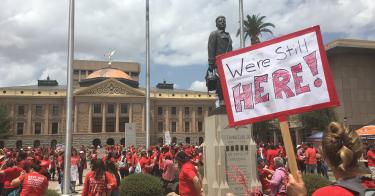Spring 2018 has brought a wave of protests by public school administrators and teachers demanding more spending on education. The protests closed schools in at least five states.
The classrooms have now reopened, so it’s time to ask an educational question: What, exactly, have we learned from this experience?
One lesson is that it’s school district officials who determine where the money goes and how much teachers get paid.
When Arizona teachers went out on strike, Republican Gov. Doug Ducey said he had the solution: the “#20x2020” plan, offering teachers a 20 percent pay increase by the 2020 school year.
Mr. Ducey signed the plan into law on May 3, but teachers shouldn’t count on getting the full 20 percent. The Tucson School District has already announced it has no intention of giving its teachers the full 20 percent raise. Rather, the superintendent wants to “spread that money around to all ‘educators’ who touch the lives of children — even the janitors.” And the more money that flows to staff, the less money there is for teachers’ paychecks.
Arizona isn’t the only state where school districts don’t always give top priority to raising teacher pay. The Oklahoma Council of Public Affairs reports that some striking teachers work in a school district that boasts an athletic center with a “ground-floor weight room, a second-floor fitness center, meeting rooms, whirlpools.” It also has an Olympic-sized pool and aquatic center.
Another batch of Oklahoma strikers came from a high school with a $10 million football stadium with “‘NFL-quality’ artificial turf.”
School districts will always have finite budgets. What matters most is how they spend the money. As Rob Burns, an English teacher in Arizona’s Chandler Unified District, said, “I’m always wondering, when the district gets its money, where does it initially go?” He adds, “Some districts know how to get it to the classroom and some don’t.”
A second lesson from this year’s teacher strikes: Calls for more taxpayer money do not end once the strikes are over.
Despite passage of #20x2020, special-interest groups in Arizona are now pushing a ballot measure to boost K-12 funding by nearly doubling the income tax rate for Arizonans making $250,000 or more. The state teachers union says it is “likely to support the effort.” Meanwhile, a group of business leaders, including a former chairman of the state board of education, are backing a 1.5 cent-hike in the state sales tax to support education spending.
Karen Deadrick, a former principal at Arizona’s Havasupai Elementary — a school that serves American Indian students in what has been called “the most remote community in America” — and now a charter school teacher, expressed doubt that demands for more funding would ever be satisfied. “It seemed like from my perspective that they keep moving the goalposts,” she said.
Mr. Burns echoes that sentiment. “There’s never enough for unions,” he said. “That puts the burden on the taxpayers.”
A third lesson from the 2018 strikes is that school closures put student learning on hold and send parents scrambling to adjust. In West Virginia, parents told local news they “weren’t sure what they’re going to do.” In Oklahoma, the “standoff [tested] the patience of parents,” even those who supported teachers’ demands.
As for students, North Carolina administrators and teachers went on strike just before final exams. The disruptions can be particularly difficult for families of children with special needs. An Arizona father of a child with autism said, “My child just started talking, and now there’s going to be a setback because someone wants more money.”
“Having a pay raise is a good thing,” said Mr. Burns, the Arizona teacher. “But down the line, when we look at the numbers for increasing money per pupil or salaries, how is it ultimately going to help the students?”
This piece originally appeared in the Washington Times




